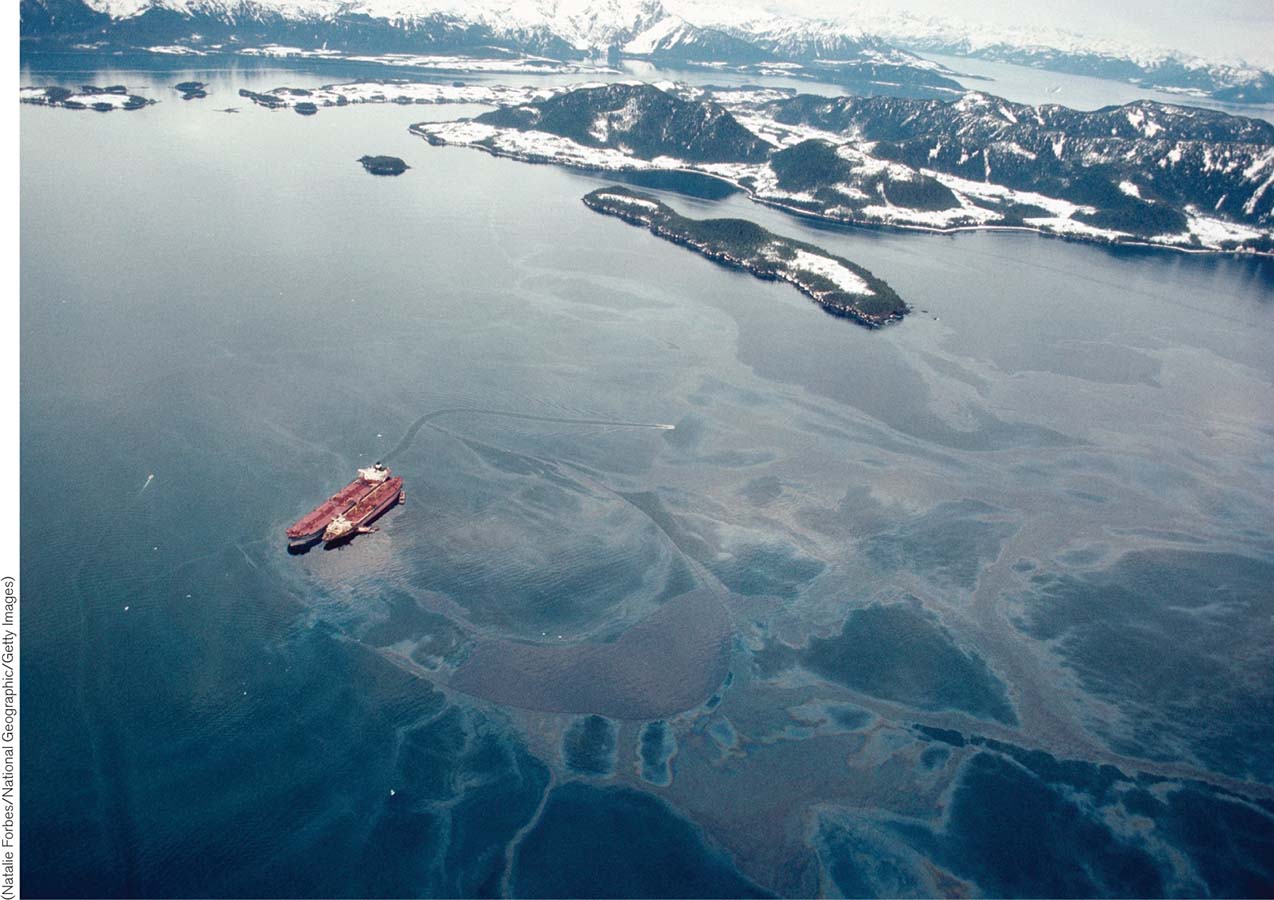9.7–9.9 Solutions
Take a ride on an airplane over the plains of Montana, and you’ll see a landscape scarred by thousands of miles of dirt roads, barren oil well pads, and long-
9.7 New laws and technology are cleaning up the oil industry
In the aftermath of the Deepwater Horizon spill, BP spent $14 billion on cleanup, over a four-
Yet it would be unfair to blame BP entirely for the oil spill. As consumers of products ranging from plastics and gasoline to natural gas, we are all, in some ways, complicit in the spill. Ultimately, reducing the impact of the oil industry is going to depend on reducing our own consumption and demanding that companies and politicians do a better job of protecting and restoring ecosystems affected by the oil industry.
In the worst-

boom A barrier used to contain oil slicks and prevent them from entering sensitive coastal areas.
skimmer A device used to collect spilled oil from the water’s surface.
dispersant A chemical used in oil spill cleanup that thins and dissolves the thick crude.
Exxon was heavily criticized for its limited response to the spill at the time, but the chemical and mechanical cleanup techniques it employed remain the standard in the industry. The most critical step in the cleanup process is to lay out floating booms and other barriers to contain oil slicks and prevent them from entering sensitive coastal areas. Next, a skimmer is used to collect the oil from the water’s surface. Passive skimmers are either enclosures that skim off only the top layer of oil or are made of materials that mop up oil. Suction skimmers, by contrast, are like vacuum cleaners that suck up the oil and pump it into a storage tank.
A second key element of the cleanup process, which was used widely during the Deepwater Horizon spill, involved using a dispersant, a chemical that thins and dissolves the thick crude. Unfortunately, Corexit, one of the most commonly used dispersants, has been implicated as a potential cause of health problems among workers, including liver, kidney, lung, nervous system, and blood disorders.
After the immediate cleanup concluded, Exxon agreed to pay the U.S. and Alaskan governments $900 million for environmental restoration and research. Much of the marine community has recovered, including bald eagles, salmon, river otters, and sea otters. However, tens of thousands of liters of oil remain buried in the beaches of Prince William Sound and will not be removed by natural processes for a considerable period of time, perhaps a century.
The most important outcome of the Valdez Spill was the passage of the Oil Pollution Act of 1990, which required companies to have a program in place to prevent oil spills and a detailed cleanup plan in the event of a significant accident. The Oil Pollution Act also led to the phase-
Regulations for Safer Fracking

What is implied by the phrase “or to an economically usable state” in the mining law requiring reclamation of mined lands?
In response to growing concerns that fracking could pose a threat to drinking water, draft legislation proposed in 2012 required that companies disclose all chemicals they use for hydraulic fracturing on federal lands in the United States. Three years later, in March 2015, the Bureau of Land Management of the Department of Interior released a set of new rules governing fracking on federal public and Native American tribal lands. A key requirement, which the gas and oil industry had long resisted, was that drilling companies must indeed disclose the chemical composition of any hydraulic fracturing fluids used.
In addition, drillers are required to protect any aquifers penetrated during drilling, using strong concrete barriers to prevent contamination by fracking fluids. There are also requirements to provide more secure storage of waste fracking fluids recovered from wells to reduce the exposure of air, water, and wildlife to the fluids. With more than 100,000 gas and oil wells on federal lands, which encompass over 3 million square kilometers (1.2 million square miles), these new rules apply broadly to gas and oil drilling on federal lands because 90% of the new wells being drilled on those lands employ fracking.
Oil-Free Zones
The only way to guarantee that a spill is not going to occur in a particular region is to ban oil exploration altogether. Following the 1969 oil spill in Santa Barbara, California, that state halted the leasing of offshore tracts within 3 miles of its coastline. Other sensitive areas have also restricted oil exploration and drilling. In 2003 Norway declared the Lofoten Islands oil-
The status of drilling on the refuge has repeatedly been a hot-
Think About It
Do you think Exxon and BP were penalized sufficiently, considering the damage that was (and continues to be) caused?
What are the pros and cons for maintaining the Arctic National Wildlife Refuge as an oil free zone?
Do you think the new governing rules for fracking on federal public lands in the United States should be extended to apply to private lands as well? Explain.